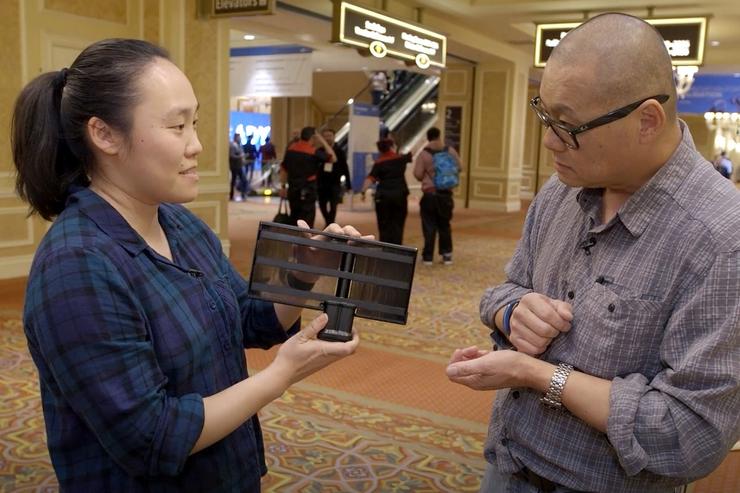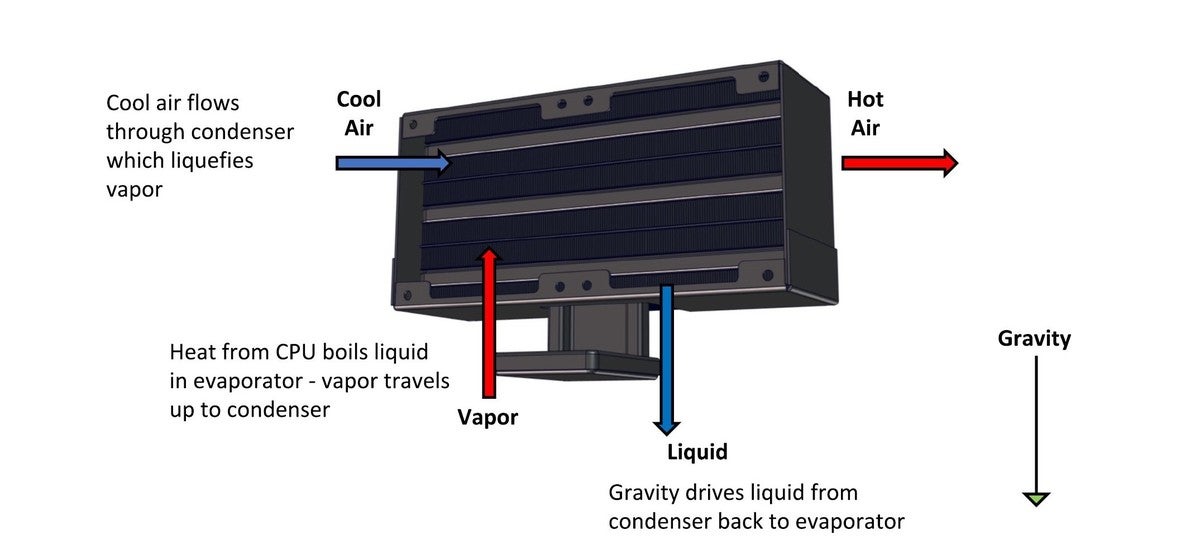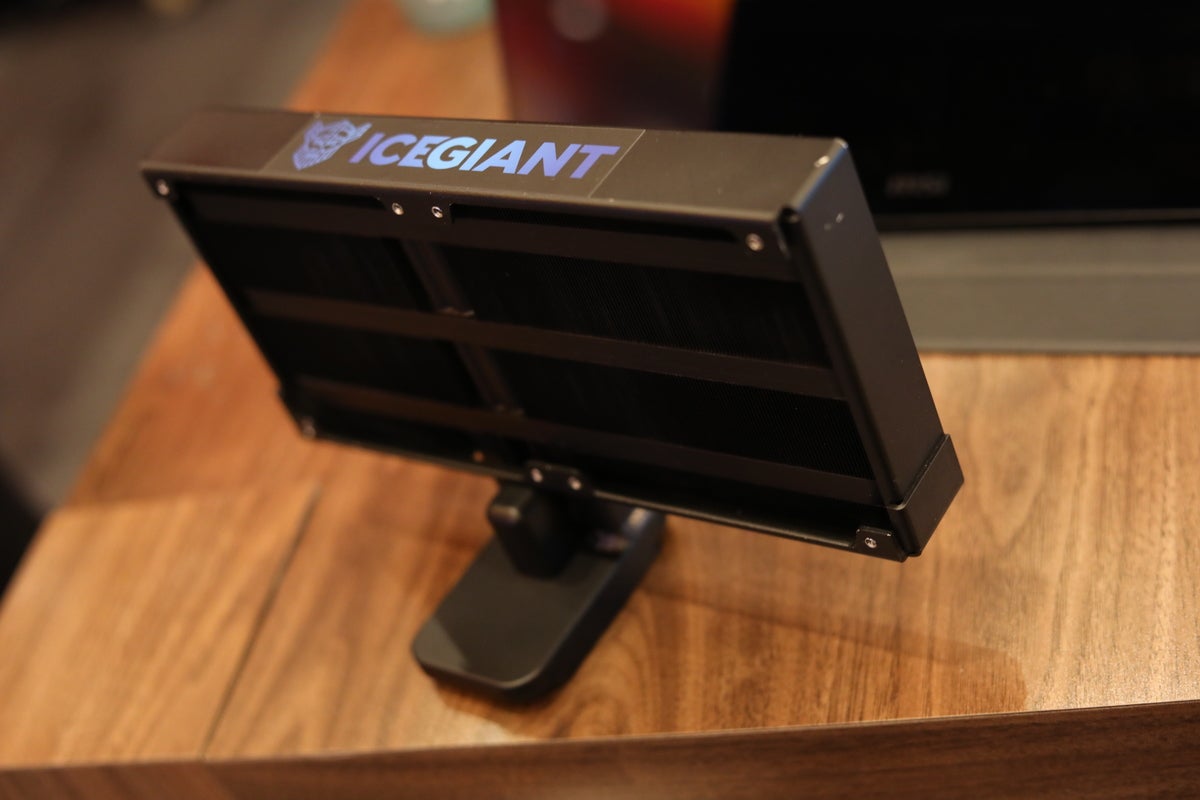 Credit: Adam Patrick Murray/IDG
Credit: Adam Patrick Murray/IDG
Where a thermosiphon is different
Heat pipes are really good until you get to the point that a CPU is producing so much heat that the amount of vaporized liquid begins to overwhelm the liquid trying to swim downstream through the wick. This state in a heat pipe is known as a “dry out,” because you now have no liquid available to transfer heat. At that point, CPU temperatures will spike.
With a thermosiphon, liquid in the evaporator portion near the CPU works much like a heat pipe, in that the liquid is in a sealed metallic body and is heated into a vapor state. The heated vapor travels to the condensers though channels where it cools off and reverts to liquid form.
The key difference now is that rather than rely on a capillary method to return to the CPU where it can be boiled again, simple gravity takes the liquid back. In theory, this method has a higher thermal limit than heat pipes because there’s no wicking method that can be overwhelmed. The volume of liquid, though still small compared to a custom loop cooler system’s, is far greater than that of most heat pipes.
Unlike AiO coolers that rely on hoses, the metal body should prevent loss of liquid. IceGIant said if you did somehow suffer a catastrophic failure in the metal body, the liquid is dielectric, so it should not harm electronics.
Thermosiphons themselves aren’t new at all, even to computers, but no one has made a successful business of it.
 IceGiant
IceGiant
IceGiant’s cooler relies on a simple thermosyphon which isn’t easy to “dry out” like conventional heat pipes.
Thermosiphon vs. the world
In IceGiant’s testing, the company said it has pushed the cooler up to 500-watt capacity. The company claims it can outperform many existing giant coolers already on the market in high-temperature applications from AMD’s giant Threadripper CPU.
For example, the company said testing of the ProSiphon Elite on a simulated thermal test vehicle show the thermal resistance favoring its thermosiphon over heat pipe designs, including the massive Wraith Ripper. In the chart below that IceGiant blogged about, the Wraith Ripper in particular hits a dry-out at far lower thresholds than the ProSiphone Elite, IceGiant claims.
It’s not just IceGiant’s claims either. The company floated prototype coolers to both Tomshardware.com and Linus Tech Tips for preview. Both previews found the prototype cooler to be very effective. Linus Tech Tip’s tests, in particular, put the IceGiant cooler ahead of not just giant multi-pipe air coolers, but also some fairly beefy All-in-One liquid coolers. It was enough for the YouTube channel to proclaim: “Water cooling is dead. Meet the Thermosyphon!”
Of course, you’re probably wondering why even go with an air cooler over an All-in-One, even if the IceGiant can outperform it somewhat. The main argument for many is reliability. All-in-One coolers have pumps which can fail over time. The slow migration of water means eventual dry-out, too. Many people just don’t like to mix plumbing and electricity, which usually means an air cooler is the only choice.
 IceGiant
IceGiant
IceGiant claims their tests show the ProSiphon can outperform heatpipe-based coolers at high-temperature applications.
Thermosiphon weaknesses
Before you throw your money at the screen, you should know there are admitted weaknesses of the thermosiphon in a PC. The most obvious is its size. Though the ProSiphon Elite above slimmed down significantly from the prototypes used by Tom’s Hardware and Linus Tech Tips, it’s still incredibly huge and simply won’t fit in many PCs The prototypes also used Delta high-rpm fans that shriek like Banshees when running. IceGiant officials didn’t say what fans would be used on final products, but they’re likely to be much lower rpm than the Delta’s. For what it’s worth, IceGiant said retail parts will match the prototype’s performance.
The other issue is orientation. Unlike heatpipes, which can work against gravity somewhat, the ProSiphon must always have the evaporator lower than the condenser for the cooling cycle to work. IceGiant has designed it so the two orientations used in most standard tower or desktop cases will work just fine.
The company also points out that although heat pipes can function against gravity, unlike a thermosiphon which stops working, heat pipes’ effectiveness drops as the liquid has to climb uphill to reach the CPU.
The last weakness of the ProSiphon Elite is that it performs best at very high thermal loads. If you’re rolling a 32-core Threadripper or an 18-core Core i9, it does relatively well. If you’re running a Ryzen 7 or a Core i7, then it really won’t matter because those CPUs don’t produce enough heat for the ProSiphon Elite to be effective. You’ll see very little difference between the ProSiphon Elite and a typical AiO or heat-pipe cooler.
 Gordon Mah Ung
Gordon Mah Ung
IceGiant ProSiphon Elite is capable cooling even AMD’s mighty Threadripper. The Elite version is considerably slimmed down from prototypes making the rounds last year but company officials said it performs just the same as the prototypes.
You need a big CPU, too
The company’s engineers said its thermosiphon design is most effective on CPU designs that spread the heat out over a larger area, such as the five chips of a Ryzen Threadripper. A tiny, single die of a Core i9 at 5GHz means lower performance unfortunately, due to the current all-aluminum design. Company officials said future designs based on copper should change this issue for smaller CPUs.
As a smaller company, IceGiant said it will focus first on producing the ProSiphon Elite for high-end desktop applications. Later this year, it’ll introduce a Stealth version optimized to be quieter, and lower-cost. The company hopes the performance of the ProSiphon Stealth will be good enough that it can be sold as a semi-passive cooler, with only air flow from case fans cooling it.
IceGiant also hopes to extend the design to cool smaller CPUs, and bring out copper versions as well.
The company said it’s expected to ship production versions of the cooler this Spring for $120.
 IceGiant
IceGiant
















